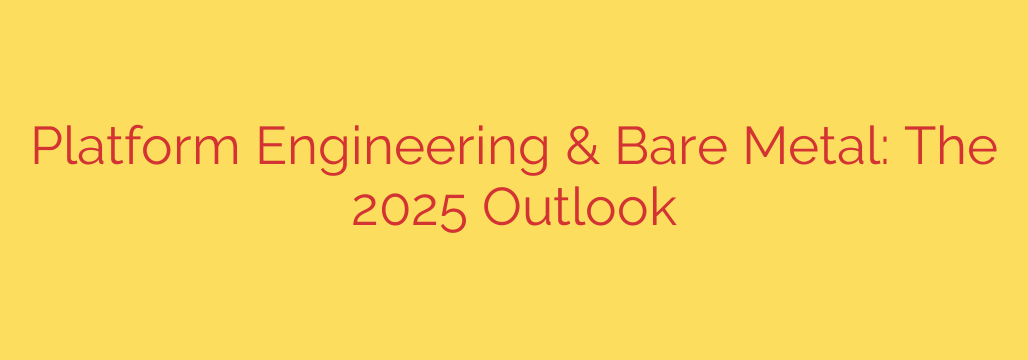
Bare Metal and Platform Engineering: The Power Duo Shaping 2025’s Tech Landscape
For years, the cloud has been the undisputed king of infrastructure, promising endless scalability and flexibility. But as organizations mature, many are confronting the harsh realities of skyrocketing cloud bills and performance bottlenecks for demanding workloads. A powerful new trend is emerging to address these challenges, combining the raw power of old-school hardware with modern software practices: the integration of platform engineering with bare metal infrastructure.
This isn’t about stepping back in time. It’s a strategic leap forward, offering a future where developers get a seamless, self-service experience on top of hardware that delivers unmatched performance and cost-efficiency. By 2025, this combination is poised to move from a niche strategy to a mainstream solution for forward-thinking companies.
What Exactly is Platform Engineering?
Platform engineering is the evolution of DevOps, focused on improving the developer experience (DevEx). The core idea is to build an Internal Developer Platform (IDP)—a standardized set of tools, services, and automated workflows that abstract away the complexity of the underlying infrastructure.
Instead of developers wrestling with intricate cloud configurations, security policies, and deployment pipelines, they interact with a streamlined, self-service platform. This IDP provides “golden paths” for common tasks like spinning up a new environment, deploying an application, or accessing databases.
The primary goals of platform engineering are to:
- Increase developer productivity and autonomy.
- Reduce cognitive load on engineering teams.
- Enforce standards for security and compliance automatically.
- Shorten the time from code commit to production deployment.
The Resurgence of Bare Metal
For a long time, bare metal—physical servers dedicated to a single tenant—was seen as slow, cumbersome, and difficult to manage. Provisioning a new server could take weeks. Today, that narrative has completely changed with the rise of Bare Metal as a Service (BMaaS).
Modern BMaaS providers offer the ability to provision and manage dedicated physical servers through APIs in minutes, just like virtual machines in the cloud. This brings the cloud’s agility to the world of physical hardware, unlocking several key advantages:
- Peak Performance: With no hypervisor layer (the software that creates and runs virtual machines), your applications have direct access to the full processing power, memory, and I/O of the hardware. This is critical for performance-sensitive workloads like AI/ML, big data analytics, and high-traffic databases.
- Cost Predictability and Savings: By eliminating the “cloud tax” of virtualization and multi-tenancy overhead, bare metal can be significantly more cost-effective for stable, resource-intensive workloads. Costs are predictable, avoiding the surprise bills that often accompany public cloud usage.
- Enhanced Security and Isolation: A dedicated server means no “noisy neighbors.” You don’t share resources with other tenants, which eliminates the risk of performance degradation or security vulnerabilities from adjacent virtual machines. You have complete control over your physical environment.
The Convergence: Where Platform Engineering Meets Bare Metal
The true magic happens when you layer a sophisticated internal developer platform on top of a robust bare metal foundation. This combination offers the best of both worlds: the raw, uncompromised power of dedicated hardware and the elegant, developer-friendly experience of a modern software platform.
Think of it this way: bare metal is the high-performance engine, and the IDP is the sophisticated dashboard and control system that makes it easy for any driver (developer) to harness that power safely and efficiently.
This powerful synergy delivers four transformative benefits:
- Unmatched Performance with a Cloud-Like Experience: Developers can provision dedicated, high-performance environments on demand through a simple portal or command line interface. They get the speed of bare metal without ever needing to worry about the underlying hardware.
- Significant Cost Optimization: By running stable, heavy workloads on cost-effective bare metal and using the IDP to ensure resources are used efficiently, organizations can drastically reduce their infrastructure spending compared to a pure public cloud strategy.
- A Fortified Security Posture: The platform can be designed to automatically apply security baselines, network policies, and access controls during provisioning. This ensures that every bare metal instance is deployed in a secure and compliant state from the very beginning, combining physical isolation with automated governance.
- Superior Developer Experience (DevEx): Ultimately, this is the most crucial benefit. When developers are empowered with self-service access to high-performance resources, they can innovate faster. They spend less time waiting for infrastructure and more time writing code that delivers business value.
Actionable Advice for Getting Started
Transitioning to this model requires a strategic approach. It’s not about abandoning the cloud but augmenting it intelligently.
- Identify the Right Workloads: Start by identifying applications that are either performance-sensitive or have stable, high resource consumption. These are prime candidates for migration to a bare metal environment.
- Build the Platform First: Focus on developing the core components of your internal developer platform. The goal is to abstract the infrastructure, so whether a service runs on a VM or a bare metal server becomes irrelevant to the developer.
- Evaluate BMaaS Providers Carefully: Look for providers that offer robust APIs, fast provisioning times, and the global footprint your organization requires.
- Security is Paramount: Remember that with bare metal, you take on more security responsibility. Ensure your platform engineering team works closely with security to implement automated patching, network segmentation, and strict access controls for the physical and OS layers.
The 2025 Outlook
The convergence of platform engineering and bare metal is more than just a passing trend; it is a fundamental shift in how we think about building and managing digital infrastructure. As companies become more sophisticated in their cloud usage, the need for a hybrid approach that balances cost, performance, and developer productivity will become paramount.
By 2025, we expect to see this model become the standard for organizations that refuse to compromise on performance or efficiency. The future of infrastructure isn’t just in the cloud; it’s in a smart, platform-driven approach that leverages the right hardware for the right job.
Source: https://www.datacenters.com/news/beyond-devops-why-platform-engineering-needs-bare-metal-in-2025








